“The Changeling”
Written by John Meredyth Lucas
Directed by Marc Daniels
Season 2, Episode 8
Production episode 60337
Original air date: September 29, 1967
Stardate: 3541.9
Captain’s log. The Enterprise is responding to a distress signal from the Malurian system, which has a population of four billion. However, the Enterprise arrives to find no signs of life—nor any signs of a disaster that would account for the population all dying. The Enterprise is then attacked by an energy beam that strikes with the force of ninety photon torpedoes. The beam moves at warp 15, but after three attacks, Spock is able to pinpoint the source. Sulu fires a photon torpedo at it, but whatever it is absorbs the energy of the torpedo and is undamaged.
Kirk tries contacting the craft, which Spock says is only about a meter long. It responds with an old interplanetary code from the 21st century, according to Uhura. Eventually the craft responds more directly, identifying itself as Nomad. It agrees to be beamed aboard. Scotty thinks that’s a terrible idea, but Kirk points out that if it’s on board, it won’t fire on the ship.
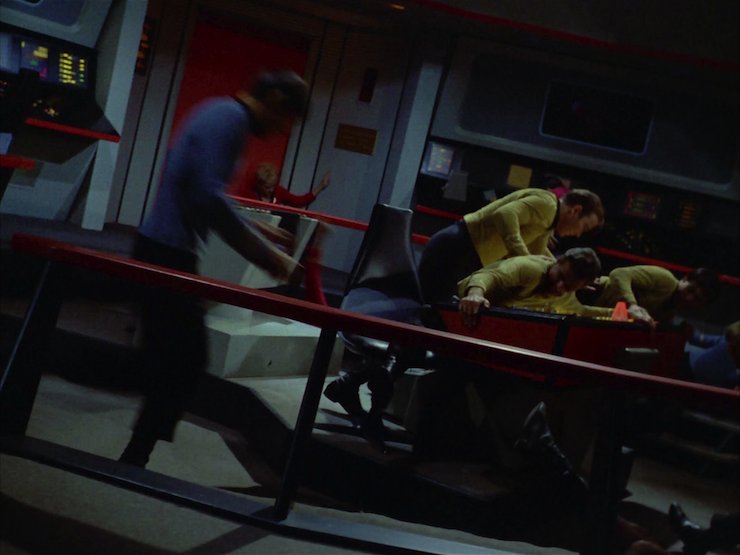
Nomad is a floating automaton, a sophisticated computer. Kirk and Spock recall an automated probe launched from Earth in the early 2000s called Nomad. It was believed destroyed. It also claims that its power source has changed since its encounter with “the other,” and is now perpetual.
They lead Nomad to auxiliary control, where they show him a chart of their home solar system. Nomad accurately deduces that it’s Earth, and says that the captain is “the creator, the Kirk.” It says its function is to sterilize any biological infestation that is not perfect. It also admits to eliminating the unstable biological infestation in the Malurian system.
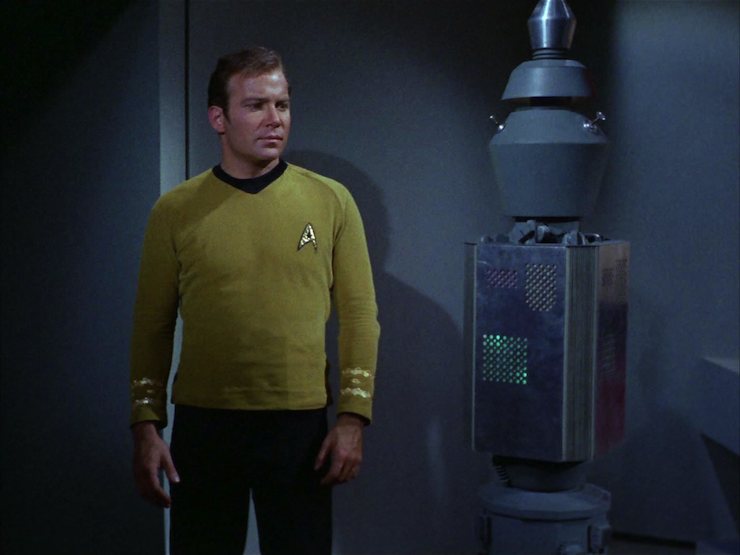
Spock digs up information on the Nomad probe, which was indeed launched in the early 2000s and was damaged by a meteor. He hypothesizes that it repaired itself, and increased its capabilities. There was a great deal of damage to its memory banks, and it now remembers only the syllable “Kirk” as its creator—it was in fact created by a computer programmer named Jackson Roykirk. Spock believes that it has decided that any biological life form that doesn’t correspond to its relentless logic in terms of what’s perfect should be sterilized.
Kirk had left Nomad in auxiliary control with Technician Singh. When Uhura checks in for an update, Singh puts her on hold to check a few things, and while she’s waiting, she starts humming. Nomad responds to this by leaving auxiliary control and going to the bridge, where Uhura is now singing. Nomad doesn’t understand about music, and so probes Uhura’s mind. Scotty tries to stop it and gets zapped and killed. Uhura’s mind has been wiped, as Nomad deemed her mind to be a “mass of chaotic impulses.” Nomad does, however, offer to “repair the unit,” referring to Scotty. McCoy provides Nomad with all the data he has on human anatomy and neurological profiles in general and Scotty in particular, and then escorts it to sickbay.
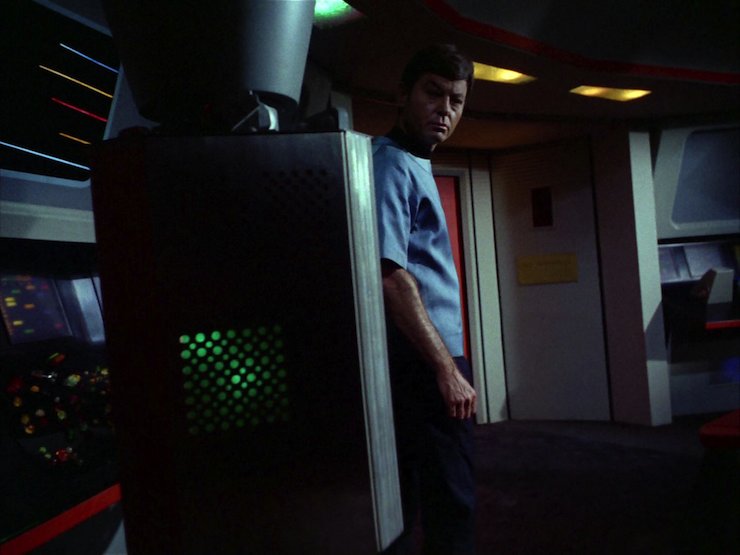
Nomad is able to bring Scotty back to life—that is to say, he repairs the unit. However, it cannot repair Uhura, because she has suffered no structural damage. Her memory has simply been wiped. McCoy and Chapel work to reeducate her while Kirk sends Spock to examine Nomad’s memory banks. The former moves along slowly, while the latter is unproductive: Spock finds several vague references to “the other” and “the accident,” but without specifics.
Spock suggests a mind-meld, and Kirk agrees, ordering Nomad not to respond to Spock’s actions. Spock performs the meld and learns that Nomad did indeed get hit by a meteor in deep space, and merged with another machine, called Tan Ru. Its purpose was to sterilize soil samples as a prelude to colonization. Tan Ru repaired and enhanced Nomad, but their directives were merged, and now Nomad is compelled to seek out new life, as Roykirk programmed it, but to then sterilize it, as Tan Ru was programmed.
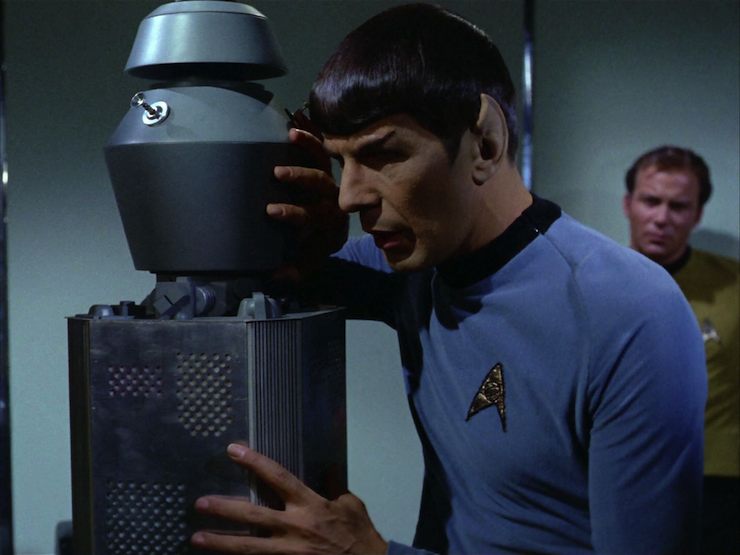
Nomad breaks out of the brig, disintegrating the two guards, and goes to engineering, where he starts to reprogram the warp engines to make them more efficient. However, sending the ship to warp eleven will damage the structural integrity. Kirk orders Nomad to reverse his “repairs” lest they’re all killed.
Spock reports that the guards are missing, probably dead. When Nomad tries to justify the murder by saying they were imperfect biological units, Kirk angrily points out to Nomad that he is a biological unit. Kirk orders Nomad to go back to the brig and do nothing. Nomad says it will reevaluate before returning to the launch point. Spock is concerned that it’s now reconsidering taking orders from Kirk and that the launch point it refers to is Earth, which it will be compelled to sterilize.
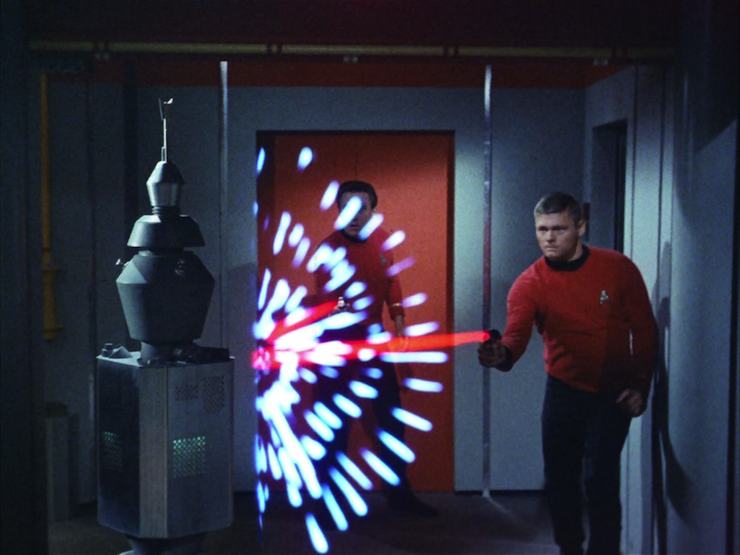
Nomad kills the guards escorting it to the brig, and goes to sickbay and examines Kirk’s medical records. Having determined that the creator is just as imperfect as everyone else, it takes over engineering and discontinues life support. Kirk goes to engineering, ordering Scotty to follow along with a pair of antigrav units. Kirk asks Nomad how an imperfect biological unit could have created something as perfect as it, but it cannot determine the answer.
Kirk reveals that he is not Nomad’s creator, that Jackson Roykirk created it and he’s long dead. It made an error by mistaking Kirk for the creator, and so it must sterilize itself. This confuses the heck out of the poor machine long enough for Scotty and Spock to slap the antigrav units on it and bring it to the transporter room. They beam it out to deep space, where it sterilizes itself.

The episode ends with Kirk joking completely inappropriately about how Nomad was sorta-kinda his son, and he regrets what might have been with regard to this killing machine that wiped out four billion lives (that we know about), as well as four security guards, not to mention the damage to Uhura and several other crew.
Can’t we just reverse the polarity? Nomad can fix people who are dead, increase warp efficiency in a starship, fire energy blasts of seriously impressive strength, absorb the energy of a photon torpedo, float through the air and navigate with ease—but its logic circuits fry because an imperfect biological unit told him he was wrong. Sure.
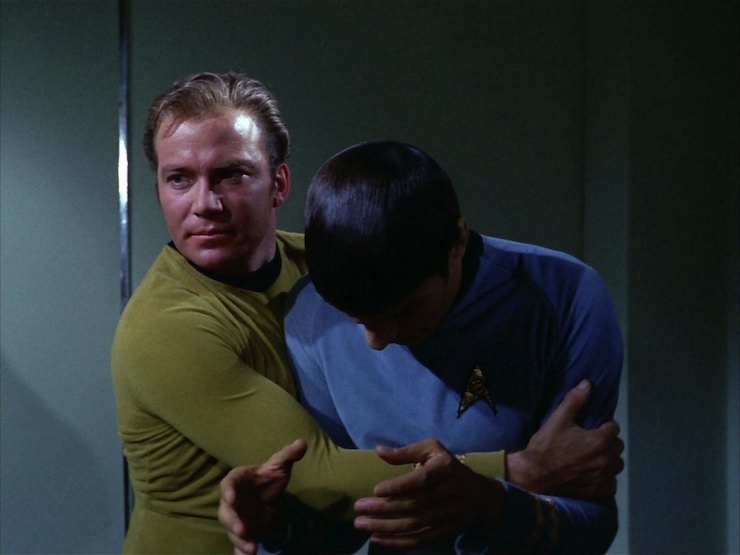
Fascinating. Somehow, Spock mind melds with a computer. Sure.
Oh, and we get more sexist Spock! He feels the need to point out that that “biological unit” is a woman, as if that’s relevant. Nomad’s response is just as sexist: “a mass of conflicting impulses.” Yeah, how ’bout those crazy gals—and they’re terrible drivers, too!
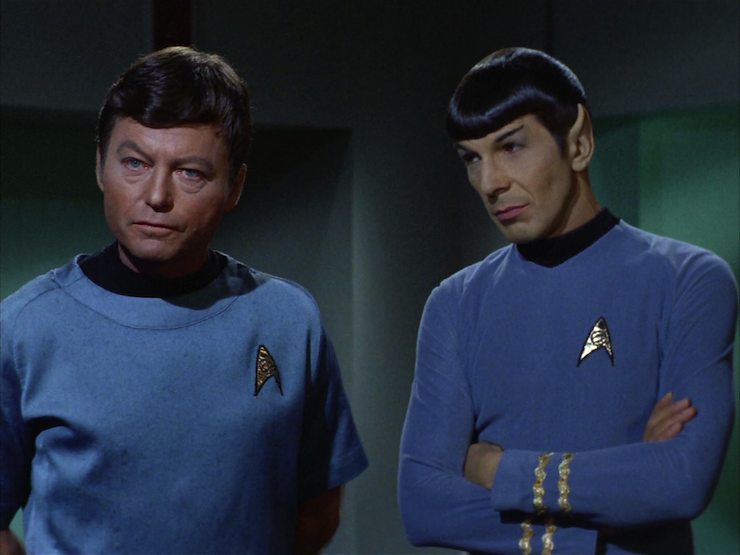
I’m a doctor not an escalator. Spock has to stop McCoy from yelling at Nomad, which probably saved his life.
Ahead warp one, aye. Sulu fires a spot-on torpedo shot at Nomad, for all the good that it does.
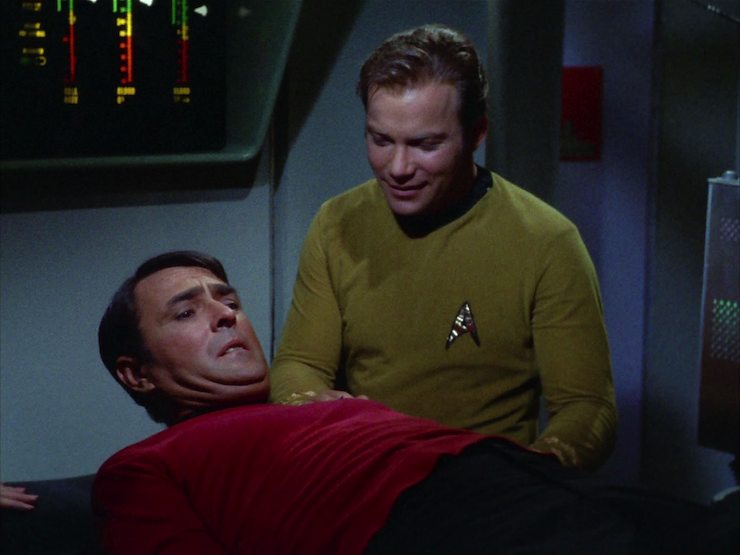
I cannot change the laws of physics! Scotty tries to save Uhura and gets killed for his trouble. This probably saves his life later, as when Nomad comes into engineering, he doesn’t physically interfere.
Hailing frequencies open. Uhura’s memory is erased in this episode, but she’s magically reeducated in time for her next appearance. It’s never made clear if, going forward, she has any real memories of what happened in her life prior to this episode, though she somehow manages to progress to college level in less than a day despite the fact that the only thing we see her do is reading second-grade-level kid books off a screen.
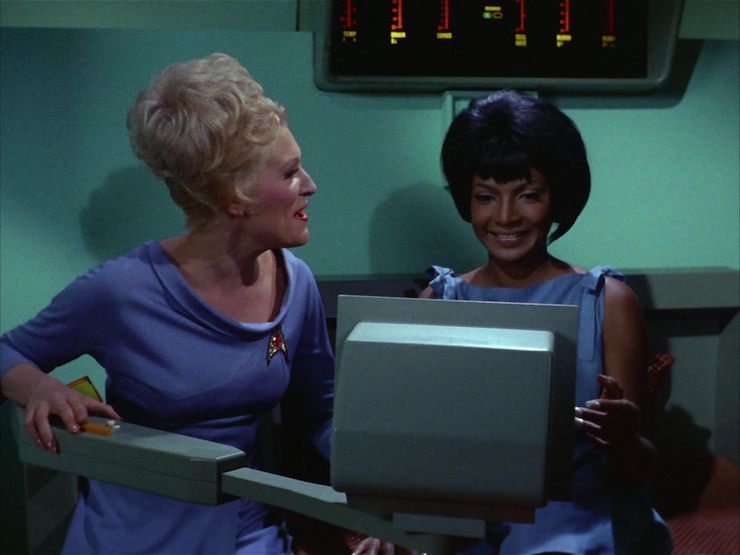
Go put on a red shirt. Four security guards are disintegrated by Nomad. After that, he only hurts Chapel and several engineers without killing them, having apparently learned that once you go redshirt, there’s no going back…
Channel open. “My congratulations, Captain. A dazzling display of logic.”
“You didn’t think I had it in me, did you, Spock?”
“No, sir.”
Spock being brutally honest with Kirk
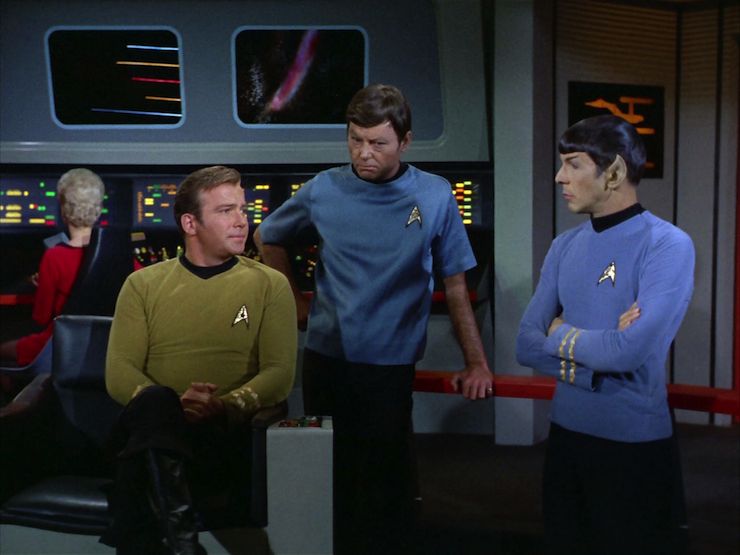
Welcome aboard. Vic Perrin, having previously done the voice of the Metron in “Arena,” returns to voice Nomad here. He’ll be back, and in front of the camera, in “Mirror, Mirror” as Tharn. Blaisdell Makee, Barbara Gates, Meade Martin, Arnold Lessing, and recurring regulars George Takei, James Doohan, Nichelle Nichols, and Majel Barrett all play assorted Enterprise crew.
Also director Marc Daniels appeared in front of the camera, kind of, as the image of Jackson Roykirk.
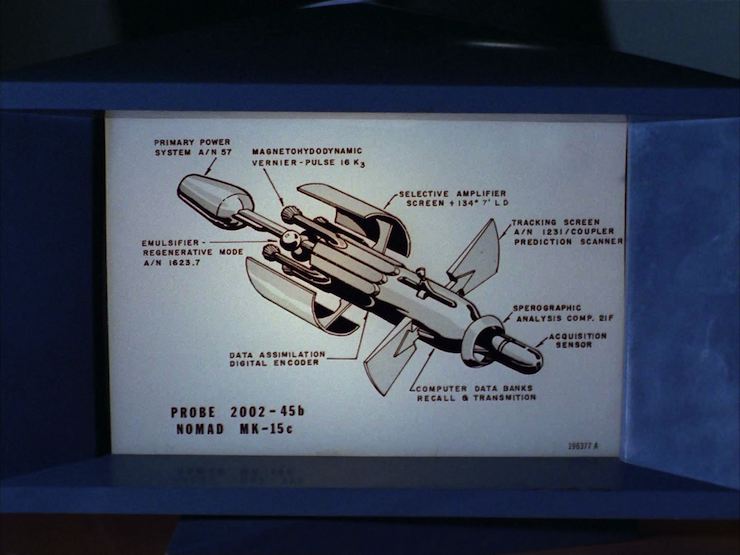
Trivial matters: This is the first script by John Meredyth Lucas, who will both write and direct several, episodes of the show, and take over from Gene L. Coon as the show-runner for the back end of season 2.
Jackson Roykirk is mentioned in Greg Cox’s The Eugenics Wars: The Rise and Fall of Khan Noonien Singh Volume 2 as being part of the team that built the Botany Bay.
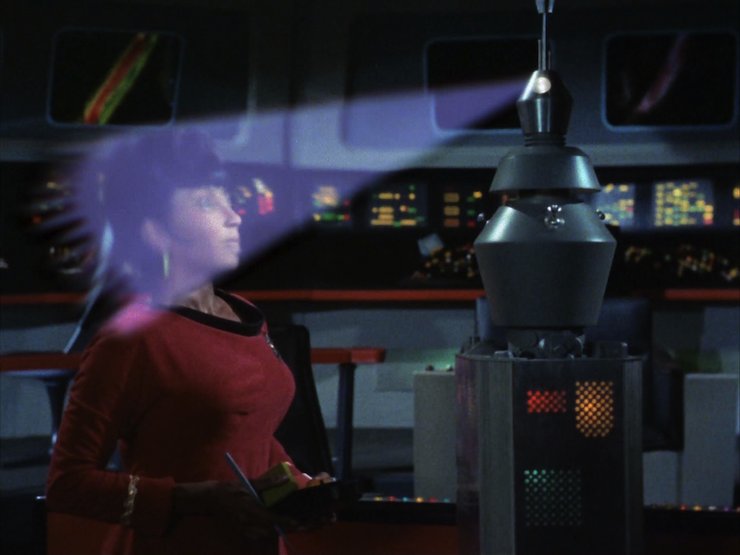
While on the bridge, Uhura is singing “Beyond Antares,” the same song that she sang to Riley in “The Conscience of the King.”
Uhura speaking Swahili during her reeducation was at Nichelle Nichols’s insistence, as she felt that that was Uhura’s first language, and so the lines of dialogue in that language were put in by a native speaker.
The Malurians were seen onscreen in the Enterprise episode “Civilization,” and in prose in regular rewatch commenter Christopher L. Bennett’s Rise of the Federation series. It was revealed that a few Malurians survived Nomad’s attack in “Communications Breakdown” by Christine Boylan & Bettina M. Kurkoski in Kakan Ni Shinkou, the second volume of Star Trek: The Manga. That manga story was also one of two tales that dealt with Uhura’s recovery from Nomad’s mind-wipe, the other being Jill Sherwin’s “See No Evil” in the Star Trek: Constellations anthology.
This is the second time we see someone killed and then resurrected on Trek, having previously seen it with McCoy and Martine in “Shore Leave.” Rest assured, it will happen again…
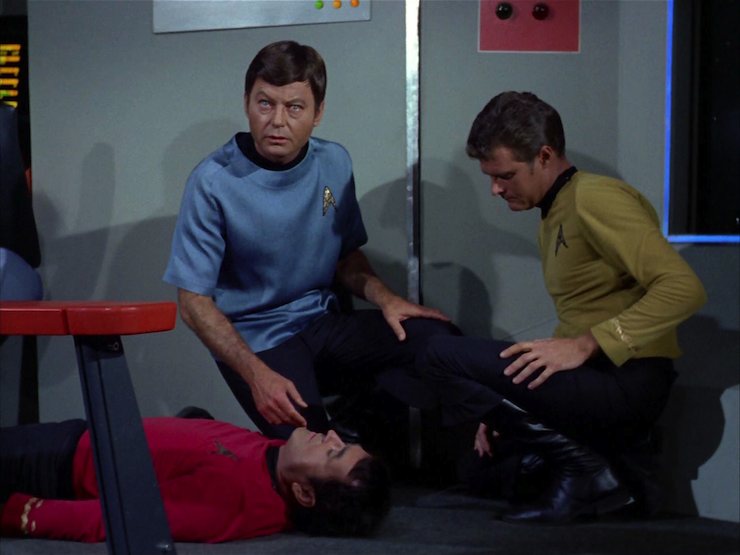
To boldly go. “It functions irrationally.” This is an episode that’s probably best remembered as the unintended first draft of The Motion Picture, as both this episode and the first feature film have the same general story structure: space probe sent out in the show’s fictional near-future, disappears and is believed destroyed, it merges with another alien construct, becomes something “greater” that actually makes it destructive, Spock mind-melds with it, and they solve the problem with human weirdness.
And honestly I don’t like either of them. The concept is a decent one, and Vic Perrin’s nasty monotone serves the role of Nomad nicely, but I just feel like everyone was a little too blasé about the whole thing. Nomad was able to bring Scotty back from the dead, and aside from a howlingly inappropriate joke by Kirk at the end, it’s barely even mentioned.
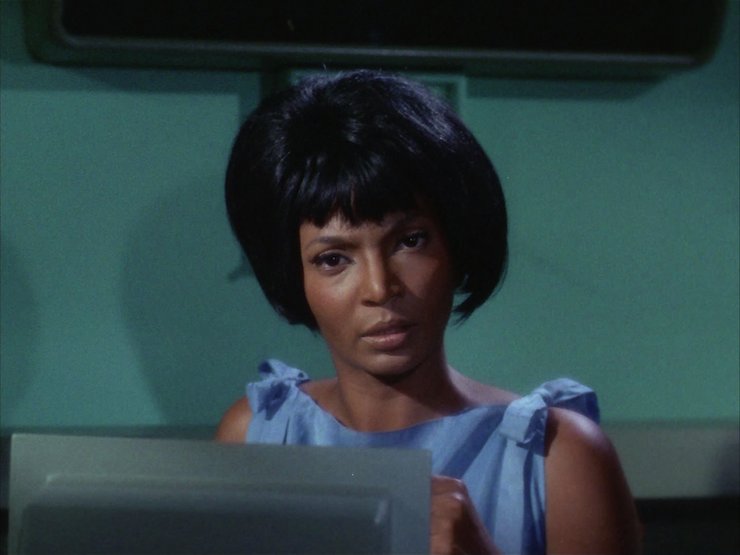
Far worse, though, is what happened to Uhura. Her memory was totally wiped out—she was, in essence, a vegetable. Everyone was talking about “reeducating” her, but that just brings her knowledge back. What about her personality? Her memories? All the things that make her a person? (This is exactly why TNG was wise to put a shrink on the ship.) That’s never even mentioned, or considered in any way, shape, or form relevant.
And then we have Kirk once again pulling the trick he pulled in “The Return of the Archons,” by unconvincingly convincing a computer to blow up in a puff of illogic. Never mind that Nomad had already decided that Kirk wasn’t worth listening to, had already decided that Kirk was a flawed biological unit. Why would Nomad—who had stopped taking Kirk’s orders—believe that he was telling the truth when he said he wasn’t the creator? And even if it believed Kirk, why would it so suddenly result in its voice getting all squeaky and it self-destructing?
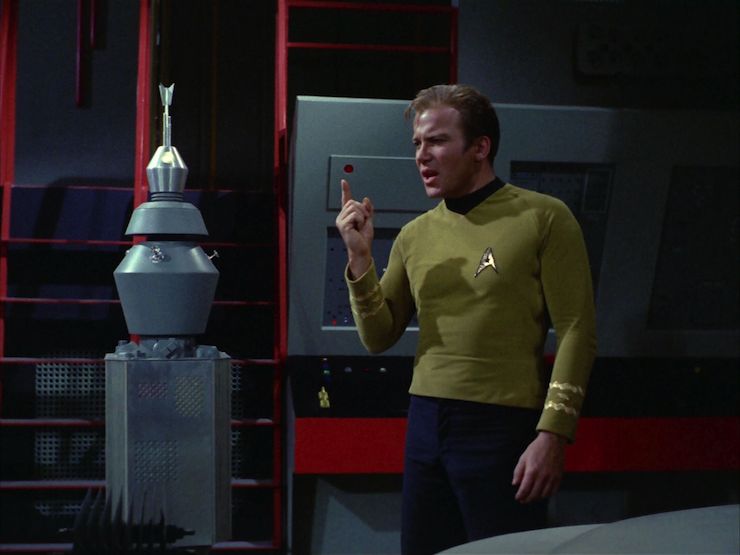
Warp factor rating: 4
Next week: “The Apple”
Keith R.A. DeCandido liked the trailer for Star Trek Beyond. So there. His latest book is Thor: Dueling with Giants, Book 1 of the Marvel’s Tales of Asgard trilogy, which is on sale today as an eBook, with the print edition to come in the spring of 2016. You can order it from Amazon, Barnes & Noble, Kobo, iTunes, or anywhere eBooks are sold. Coming soon are Books 2 & 3 of the trilogy, Sif: Even Dragons Have Their Endings and The Warriors Three: Godhood’s End.










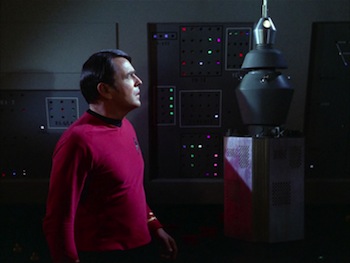
Ddi the show often head to wiped out colonies in order to avoid spending money on extras?
One of my friends and I in middle school filmed one episode (count ’em, one) of a Star Trek-themed talk show he wanted to put on our local public access cable station. (It was 1986, the heyday of such things.) Blessedly, the tape has been lost to the ages; however, I do remember the name of our “production company” was “The Ball is Blu-ie Productions.”
As I say – all blessedly lost.
Still, I have fonder memories of this episode than Keith does. He raises valid criticisms. I’ll have to watch it again and see what I think (hey, novel thought for a rewatch…)
Pictured: Deanna Troi at the helm.
But jokes aside, yeah. That is a pretty insulting way to refer to and treat a woman at all. I like to assume that Nomad (or New Horizons, is it?)’s view of wiping a a mind is like putting something in the “Windows” trash can. It isn’t gone until it is overwritten and all they had to do was sort of jog Uhura’s memories and give her a structure to recover them. The only thing she lost was the memory of those illogical couple of dates she went on with Spock, but the good news is she got a red hot crush on Scotty instead.
Wasn’t McCoy killed and then resurrected in “Shore Leave?”
The Usual Suspect: Crap! You’re right! Derp! Will edit.
—Keith R.A. DeCandido
More Trivial Matters: The Malurians were seen onscreen in Enterprise: “Civilization,” revealed to be a people with interstellar capability. The story “Communications Breakdown” in Star Trek: The Manga — Kakan Ni Shinkou, set shortly after “The Changeling” and dealing with Uhura’s recovery, establishes that some Malurians survived the extinction event, using the ENT design for the species and giving us our first full-face look at them (since we only saw one half-unmasked in “Civilization”). I’ve also featured the Malurians as antagonists in Rise of the Federation: A Choice of Futures and Tower of Babel, and have tried to address how a race with interstellar capability could’ve been all but totally wiped out when their home system was destroyed.
A different version of Uhura’s post-“Changeling” recovery was shown in “See No Evil” by Jill Sherwin in the anthology Star Trek: Constellations.
Somehow, nobody ever seems to have picked up on the dangling thread of just who created Tan Ru. That was one hell of an advanced technology, able to pack planet-destroying capability in a box the size of a tool chest. Why would any planetary survey probe need that kind of power?
The ‘inappropriate joke’ endings, which seemed prevalent around this point of the series, are one of the reasons I hold Star Trek’s third season in somewhat higher regard than many. For all its faults, third season episodes tended to acknowledge the consequences of whatever bad stuff had just transpired, often ending on a note of melancholy.
@6: If I recall correctly, a pre-“Changeling” encounter with Tan Ru was in the cards for Enterprise S5, but obviously it never had the chance to happen.
Also, I don’t see the issue with mind melding with an artificial intelligence. Telepathy doesn’t make any sense anyway either in mechanism or in manifestation (How would one brain ever directly understand the meaning of specific mental configurations in another brain without some intermediary means of translation? Even two twins wouldn’t have the same mental image correspond to the same configuration of neural impulses), it being a non-biological brain doesn’t suddenly make it make less than no sense. Melding with Nomad (or V’Ger) doesn’t seem any odder to me than melding with a Horta. If a being has the capability of connecting their mind with another, why would it matter what kind of hardware the electrical impulses of that mind is running on? An intelligence is an intelligence.
@8/Idran: In my debut novel Ex Machina (which dealt with machine intelligence), I addressed the issue of Spock’s ability to meld with computers. Here’s what I wrote (on p. 314):
Thank you, Christopher!
Quick, Robin — to the edit function!!!!!
—Bat-Keith
“Oh, and we get more sexist Spock! He feels the need to point out that that “biological unit” is a woman, as if that’s relevant.”
It was relevant to set up Nomad’s cheap shot line.
I think Nomad did not take anything out of Uhura’s brain, it just scrambled her filing system as it were. All her knowledge and memories are still in her brain, she just has reestablish connections to them by refamiliarizing herself with the basics. That would be why she seems to have command of speaking Swahili so soon, it has the most well worn pathways for her. Anyway,it makes more sense than what Chapel and McCoy say they are doing for her.
As to the ending, while Nomad has become skeptical of Kirk. When faced with its “Creator” forcefully imparting information it is hard for Nomad to outright ignore him. Nomad is demonstrated very limited in going beyond its understanding of its programming in certain areas.
I never thought about it in these exact terms till I read a few comments on here, but I too always assumed Nomad never TOTALLY fried Uhura’s brain given how quickly she re-acquired Swahili. I suppose “in the trash can but not overwritten” was what I was assuming all along.
It was never actually stated in the episode that Uhura had her memory wiped. Nomad’s exact words were “knowledge banks”. So it could very well be that her memory and personality were intact; she just didn’t have the knowledge to express them.
I have one nitpicky problem with Nomad’s mistaking Kirk for his creator. At one point Nomad specifically asked, “Is the usage incorrect?” and Spock was quick to say, “the usage is correct” once he discovered who the real creator was. So Nomad’s second “error” in Kirk’s speech (that he didn’t discover his first error), was largely because Spock lied to him.
A silly episode that inspired a pretty decent movie. Yeah, yeah, Motionless Picture. I’ve heard them all. I still like it.
Warts and flaws and all, plot holes and offensive lines and reset-button-joke be damned, this is one of my few absolute favorite episodes. I’m trying to figure out why. I think partly it has quintessential Trek ingredients, silly as some of them are. And it’s one of the handful of episodes that I saw in childhood and never forgot — most episodes blurred into one in my mind over the years, but this grabbed my subconscious and conscious mind. Nomad is really menacing, for one thing. And to find a solution to their dilemma, the crew has to first understand Nomad, then use intelligence to disable it. Classic stuff. I forgive all the flaws and gaps.
Here’s the nitpickiest of nitpicks: “lest” requires the subjunctive mood in the following clause. So “lest they’re all killed” is wrong; it should be “lest they all be killed”.
Reeducating Lt. Uhura is more likely a failing on everyone involved not knowing what the hell they were talking about. A metal golf bag that can kill planets? Sure, these folks are thinking things through.
The best part of TMP was the opening undercard: Klingons vs. V’ger.
I really wonder if the writer was learning disabled in some way because, speaking from experience, this episode is the primal LD nightmare. I am not talking figuratively. Mistakes that were normal for a kid with my limitations were treated like cardinal sins. I lacked the motor skills to do zippers till I was seven or eight. So, I walked home in blizzards with my coat open because my teacher announced we were too big to need help with our coats and couldn’t ask for help with them anymore. As for academic errors . . . oi, don’t get me going. Because your mistakes are so different from the normal kind–not worse, just different–they make you feel like a combination leper-zombie-ax-murderer on the something-is-wrong-with-you scale.
Honestly, do these teachers go to rehap centers and stand around telling people in wheelchairs that, if they can still use their arms, of course, they can use their legs. “It’s the same thing,” “Why aren’t you trying?” “You just don’t care.”
So, the feeling that any error, no matter how small, may be instantly fatal? That feeling that actions are being constantly, ruthlessly judged? Oh, yeah. To this day, when I’m having a hard time with something that touches on my LD, I think of this episode. Really.
And the bit with Uhura? After all the grief you get for not being able to play the game on normal people’s terms, when “normal” people can’t grasp something you find perfectly clear and straightforward, who’s the one who gets in trouble? Who’s the one who feels like they’re being treated as a little toddler who doesn’t even grasp rudimentary skills? Hint: It’s not the “normal” person.
To have the judgmental, “normal” terror have the tables turned on him and fall victim to his own judgmentalness may reek a bit of wish-fulfillment–but it’s a very nice wish-fulfillment.
Still, this episode really is nightmare fodder for me. To this day, just the idea of it freaks me out.
“once you go redshirt, there’s no going back”
That would’ve been a great line for me to try out at a con, oh, 3 decades ago. ;-)
I always had a soft spot for this episode because of its silliness. Wouldn’t Nomad scan the Enterprise’s memory banks and immediately figure out that Kirk wasn’t Jackson Roykirk? I always enjoyed the fact that this advanced piece of hardware couldn’t figure out such a simple omission. And maybe it’s because it was endlessly parodied on animated shows like Futurama, but you can always get me to laugh at scenes involving Kirk outsmarting a computer with logical arguments. Ever try watching this episode dubbed in Portuguese? Nomad’s voice alone is enough to drive viewers into hysterical laughter, specially when its logic circuits are frying.
But, you’ll get no argument from me. This is definitely a silly and poorly thought episode. One cliché after another. This episode also deserves an award for most inept redshirt behavior. None of those guards are capable of following through with their orders and keep an eye on Nomad. Of course, Kirk just had to leave them unattended in order for the script to drag long enough for a full hour.
Ironically, The Motion Picture is by far one of my all-time favorite Trek films. I love the 1970’s sense of pacing, the score, the visual effects, and the way the story involves real character emotional stakes through Spock, Decker and Kirk. It only goes to show how much execution can improve a token stray probe plot. Kudos to folks like Robert Wise, Jerry Goldsmith, Doug Trumbull, Roddenberry and the actors on that front.
Having said that, it occurs to me that between this and Elaan of Troyius, John Meredyth Lucas has a really spotty track record. Almost as bad as Freiberger, despite a couple of decent shows under his brief stewardship as producer/showrunner. Of course, both Genes still approved this episode, so they’re not off the hook either.
I like this one. It’s silly, but enjoyable.
Not only does mind-melding with a machine make as much (or as little) sense as mind-melding with a person, I also find the scene quite intense.
Am I the only one who enjoys the fact that Kirk says “It thinks I’m its mother” (instead of “father”)?
In the final scene in engineering, I like it that Kirk pauses to check whether his people are still alive before confronting Nomad.
I don’t think it’s a contradiction that Nomad believes Kirk even though it has stopped obeying him. Nomad probably doesn’t have a concept of lies, but treats all input data as facts. Neither of its previous assignments required any knowledge about lies.
I’ve long since decided that talking a computer to death is just Kirk’s superpower. He has already done in Landru from Return of the Archons. He will get to M5 and Harry Mudd’s androids. He’ll even accidently kill an android in Requiem for Methuselah. It has to be a superpower. He just doesn’t realize he has it.
I like to think there is teenage boy somewhere in Iowa with the last name Kirk wondering why his iPhone blows up whenever he talks to Siri.
Interesting how the only stories dealing with Uhuras recovery were written by women.
@10 – krad, don’t you mean “the Bat-Edit Function”? Complete with label?
Star Trek: The Motion Picture: Where Nomad has gone before.
clap clap clap, dwarzel
Those “Motionless Picture” and “Where Nomad Has Gone Before” jokes are older than I am.
Nice screencap of Nichelle Nichols looking directly into the camera, as if to say “Can you folks at home believe this crap? And what am I even wearing?” Maybe that’s supposed to be a future-y hospital gown, but it looks more like they decided to put her in an oversized child’s sundress while they treated her like a preschooler learning to read.
@26/Majicou: Not that today’s hospital gowns look any better.
By the way, Kirk wears the same gown in “Turnabout Intruder”. And in “Space Seed” you can see the male version.
@22 Robert–thanks for my Laugh of the Day!
@21 Janajansen–yes, I, too, like the fact that Kirk says “mother.”
I just realized! Kirk uses his power in “Wolf in the Fold,” too! When Red Jack/Piglet gets in the computer and he manages to use up all the memory with a single math problem, he was really just using his power on its lowest setting!
He probably did the same thing with the Kobayashi Moru.
I wonder how many times he accidentally blew up the academy computers before getting it right. . . ?
@29/Ellynne: Well, maybe. It was Kirk’s idea to set the computer an insoluble problem, but Spock was the one who actually gave it the command.
In James Blish’s adaptation, Kirk says “father” instead of “mother”. Since Blish worked with early versions of scripts this could have been changed later.
@29/Ellyne – He probably did the same thing with the Kobayashi Moru. Ha! I really like that suggestion.
I don’t find anything odd about Kirk saying “mother”, he’s referring to the common trope of newly-born animals imprinting on the first person they see.
I didn’t mean that it’s odd, I meant that I like it.
My bad.
Man, see, y’all are talking about Nomad, and stuff, and I’m just like oh my god there’s Star Trek manga.
MeredithP: Yup, four volumes, published between 2006 and 2008. :)
—Keith R.A. DeCandido
You know what just occurred to me? We make comment on Spocks casual sexism. Now sexism is illogical, so that makes little sense. But I think Spock just doesn’t get women. Especially non-vulcan women. The only one he knew was his mother. And compared to everyone else on Vulcan, she was an overly emotional woman with a chaotic brain. So when he meets others females, he notes every difference and over exemplify’s them. So to his logic, those differences are logical. Probably explains why he never had kids.
Just spit-balling here. Don’t kill me.
Cleggster: as rationalizations go for Spock’s behavior, that’s actually not bad…. :)
—Keith R.A. DeCandido
@38/Cleggster: Sorry, I don’t think that works, since by this point in the series, Spock has been serving in Starfleet for at least 15 years, and if you add his time at the Academy, he’s been living among non-Vulcans for more like two decades — which is more than half his life. So he would’ve met and interacted with plenty of women of various personality types — not to mention serving under Number One, a coolly rational woman, for some time.
The Uhura mind erasure really took me out of the episode.
Hm, I find very little genuinely silly in this episode except for the strange idea with Uhura’s memory wipe. It’s structurally not unlike Charlie X because in both cases we have a far superior power which can not be controlled by the crew and the Enterprise technology, just Kirk’s authority keeps the danger in place … until it doesn’t.
This episode is also noticeable for the longest take in the whole of TOS which is Spock’s mind meld, a virtuoso 163 seconds performance by Leonard Nimoy.
@42/Lubitsch: I find it silly that two robots meet by chance in space, manage to repair each other and are so powerful afterwards that they can wipe out whole planetary populations.
But the mind meld scene is great.
@42/Lubitsch – That is an awesome piece of Trek trivia! Did you realize that on your own? Whether or not, thanks for sharing it – very cool. It is an incredible take, as I recall.
@45 You can see my analyses of Star Trek episodes on http://www.cinemetrics.lv/database.php , I’ve measured the first four series and the feature films.
@43 Well, that’s called storytelling ;-). Admittedly the earth probe couldn’t have brought much to the table technologically and since the other probe was just there to sterilize samples, it’s hard to see where the immense firepower is coming from. TMP manages a more convincing explanation.
Still I think this episode builds nicely a dramatic curve pitting the crew against an invincible foe not unlike in The Doomsday machine.
@45/Lubitsch: Agreed – I’ve always thought of this episode as a more light-hearted companion piece to “The Doomsday Machine”, because both times they encounter a machine in space that wipes out entire civilizations, and both times they destroy it in the end.
Ah “The Changeling.” Another guilty pleasure of mine. Everything krad says about it is absolutely true. The one thing that always takes me out of the episode is Uhura’s memory wipe. It’s never explained how Uhura manages to become herself again. That always bothers me.
Holy Crap!
I’m coming late to the party, as usual…but I just watched this one the other night and I realized that I had seen it when I was only about three or four years old, during the original run or very close to it…and Nomad scared the *bejeezus* out of me! To the point where I was “Trek-phobic” for years afterward!
In fact, just that flat voice intoning “I am Nomad. I am perfect” and realizing that that phrase was still in my head from almost *50 years ago* was enough to creep me out a bit!
So whatever “The Changeling’s” failings in logic, etc as an episode, it still works for me as flat-out horror!
Also late to the party, but instead of beaming Nomad onboard why didn’t they just not materialize it like Scotty wanted to do with the Klingons in ‘Day Of The Dove’ or scramble its pattern like happened by accident in STTMP? Problem solved.
@50/mroktober: Because Starfleet is not in the habit of murdering aliens as a default response. They prefer negotiation first. They beamed Nomad aboard in order to talk to it and understand it. If they’d used destruction as their first option, they would’ve been as bad as Nomad.
While I admire your dedication, I must admit it seems weird that you’re spending so much time watching and writing about a television show you don’t like very much. After all, criticizing old films and television shows for not demonstrating contemporary mores and values is a losing proposition.
@52/Marty McKee: You think Keith doesn’t like Star Trek? Wow, you don’t know a thing about him. He’s not only written or edited a ton of Star Trek tie-in books, e-books, and comics, but he has a nigh-encyclopedic knowledge of the franchise. He wouldn’t be so invested in it if he didn’t love it. But you can love something and still be honest about its flaws. Indeed, they kind of go hand in hand.
What can I say that Chris hasn’t in his previous post?
The shots of the camera connected to the side of Nomad as it floated through the halls kinda creeped me out as a kid, but I love this episode. Every time I hear the word sterilize I play it back in my head in that high-pitched, drawn out tone.
I know it’s not really possible to delve into the complex emotions of empathy and grief for any length of time in the context of a bite-sized self-contained episode that is not ABOUT empathy or grief, but the way this episode started, with the revelation of 4 BILLION lives lost, stuck with me for the entire 50 minutes, and not in a good way. As Keith points out, Kirk and the gang just kind of gloss over this horrifying tragedy that takes out an entire system (not to mention crew members that he presumably was acquainted with) and they have a good laugh in the end. Ho ho. I realize the premise was written for dramatic effect, but my personal preference would have been for NOMAD’s path of sterilization to have been less terrifyingly thorough and complete, or for our heroes to convey a more profound reaction to what was lost. This just didn’t hit me right…. not one of my favorites.
Also it was strange how nonchalant the crew was about having this thing that killed billions on board. From Uhura’s mindless singing, to Sulu not paying attention and almost being being struck by it when it was on the bridge. I guess it was just another day at the office for them.
Is this the biggest genocide shown in an episode of Trek? 4 billion killed and the episode ends with a joke!
@59/Ryamano: The largest genocide in onscreen Trek was probably Kevin Uxbridge’s eradication of the Husnock species in TNG: “The Survivors.” According to him, that came out to some 50 billion lives.
Otherwise, Nero’s destruction of Vulcan killed 6 billion. And we saw various civilizations that had been exterminated in wars, like the people of Cheron, or the Pralor and Cravic races in VGR: “Prototype.” https://memory-alpha.fandom.com/wiki/Genocide
I always liked Kirk being able to out-logic Nomad (perhaps because its original programming was so corrupted?) I also wonder how the loss of an entire spacefaring civilization could have gone unnoticed apparently so close to the Federation…
Uhura’s brain does appear to have been more “scrambled” than erased; kind of like Sam Beckett’s brain getting swiss-cheesed in Quantum Leap. Favorite line from her: “The sky is blew-e…blew-e?”
You never call, you never write….
I think the logic attack Kirk used wasn’t so outlandish. It wasn’t a question of trusting Kirk–Nomad was obsessed with eradicating imperfection, and the truth of Kirk’s accusation of errors was plainly true once pointed out. He wasn’t outsmarting Nomad, he was exploiting corrupted directives.
Many years ago, in the late 1980’s, I re-watched this episode with a group of friends. Some of us were law students. While others were science and philosophy majors. After viewing the episode, one friend directed these two questions* to the group:
1. Can an imperfect being create perfection? and
2. Can a perfect being create imperfection either intentionally or unintentionally?
I can tell you that was an interesting discussion!
*These questions were in reference to Nomad’s comment to Kirk that “the creation of perfection is no error.”
@64/Paladin: First, you’d have to define “perfect.” Perfect by whose standards? Perfect for what purpose? Something that’s perfect in one context can be deeply flawed in another.
Anyway, if there were such a thing as a perfect being, I don’t think it could create anything, since the incentive to create is need and incompleteness. This was interestingly illustrated in the Japanese tokusatsu show Kamen Rider OOO. The villains in that season were artificial beings called Greeed [sic], made out of coin-like “medals” (which the Os in the title represent), the numerous “Cell Medals” making up their bodies and the nine “Core Medals” containing their life force, powers, and consciousness. When they were first created by medieval alchemists, they had ten Core Medals each, but they just sat there inertly. They were alive but dormant. But when one Core Medal was destroyed, they suddenly came to life — because now they were no longer perfect. Now they were incomplete and had a need to strive for, and that desire to fill the void was what drove them to live and think and act. I found that an interesting philosophical notion.
@64/CLB: IIRC, my friend meant “perfect” in all ways as in the sense of Thomas Aquinas’s version of the Christian God (the ultimate perfection of being).
@66/Paladin: That sounds circular to me — “perfect” means being perfect. It doesn’t answer the question at all.
@66/CLB: Agreed.
#66/paladin. I dunno, ask Mary Poppins.
Mary Poppins is only practically perfect.
I’m going to add another character to the cast for the purpose of this comment. And yes, I know it’s not an actual crew member :P
Non sequitur. Nomad’s part in the story.
Non sequitur. Nomad fires a beam with the equivalent force of 90 photon torpedoes and the Enterprise survives. Sure.
@71/Thierafhal: Did TOS ever establish how many photon torpedo hits it would take to batter down a Constitution-class starship’s shields if they started at full power? Later productions probably suggested that a few could do it, but we can assume those were a later, more powerful variety of torpedo.
@72/CLB: That’s actually a very good point, although 90 does seem to be an awful lot of something called a ‘torpedo’ for the Enterprise to survive getting hit by. There’s also another way to look at it since the ground rules (space rules?) for starship combat were still very much evolving, canonically. Perhaps starship shields at full strength could absorb an astronomical amount of energy as a one-time thing, fully protecting the ship from damage. They’d be shorted out, of course, until they could be repaired.
@73/Thierafhal: Except that Spock clearly said that the 90-torpedo-level hit only reduced their shield strength by 20%. Suggesting they could take a total of 450 torpedo hits, unless the deterioration was exponential rather than linear.
In any case, 90 torpedoes would not be remotely near “astronomical.” A TNG-era torpedo would have a yield of 64.4 megatons according to the TNG Tech Manual (3 kg of matter & antimatter times c squared), so 90 of those would be about 5800 megatons. The asteroid that killed the dinosaurs had an impact yield more than 17,000 times greater than that, and even that’s a pittance compared to a star’s output.
@74/CLB: Well thanks for all the stats. I was really kinda just thinking aloud with my last comment. My use of the word ‘astronomical’ was not a defined number in my mind, haha, it was just the word I chose in the moment to represent “a lot of energy”. Obviously I didn’t recall the 20% line from the episode regarding the shield drain after the hit from Nomad.
Sorry, I’m not trying to dismiss your comment, I appreciate the clarity from your numbers.
So, do the shields on the Enterprise deflect the energy from phaser beams, photon torpedoes, nukes and rocks? Or, do shields absorb the energy? Or, do the shields do both? And, if the shields absorb energy, where is that energy shunted to?
@76: I mean the shields surrounding the Enterprise.
@76:
You know how the lights always flickers, the artificial gravity rocks everyone back and forwards, and then a console overloads and occasionally explodes? There ya go. The shields shunt it through every system they can find so it disperses in lots of little ways instead of one big boom.
@77: Ha ha ha ha ha ha ha ha ha ha!
@78, good piece of reasoning
@76: It depends upon who you ask. The shields usually seem to diffuse attacking energy to the point that it can’t do damage any more. Although there’s a limit to that before the shields fail. On the other hand, there has been made a reference to Mr. Scott’s Guide to the Enterprise which came out about the same time as The Motion Picture. That book said that the shields were much like a replicator, creating an invisible layer of energy that was like the material that the Kalandan ghost planet was made of, diburniam (sp?) which was incredibly phaser resistant.
This was the source for the comment about the new shields holding in TMP against V’Ger– but those didn’t last too long either. I guess that proves no starship’s shields were ever perfect as they were only as good as the energy supply feeding them. And like all military developments, once the shields got stronger, people developed more powerful torpedoes to go through them. By the end of DS9, they had been using quantum torpedoes. Or like they did in Generations where the Klingons found out the shield modulation frequencies and sent their torpedoes through the E’s shields like they weren’t there…
@76/Paladin Burke: “So, do the shields on the Enterprise deflect the energy from phaser beams, photon torpedoes, nukes and rocks? Or, do shields absorb the energy?”
The answer’s right there in the name “deflector shield.” To deflect something is to turn it aside, to change its direction. As seen in The Making of Star Trek, the term “deflector” first came up in development as a term for a field or beam that would push space debris and dust out of the ship’s path (i.e. the navigational deflector beam), which Roddenberry’s scientific consultants suggested could be a laser beam or an electromagnetic force field. The concept of “deflector screens/shields” evolved from that. You can think of it as analogous to the Earth’s magnetic field, which deflects harmful solar and cosmic radiation (basically trapping it in the Van Allen belts) and keeps it from reaching the surface. Although a more advanced, sci-fi application that works on electrically neutral matter as well, or maybe imparts a charge to it so it can be deflected magnetically. (Except that wouldn’t do any good against gamma radiation or x-rays.)
The TNG Technical Manual explained the deflectors as gravitational fields that just bent the path of incoming matter and energy away from the ship (although that should really make the ship invisible to the outside universe and vice-versa — there was a handwave about the shields being tuned to let some light frequencies through, but that would make them vulnerable to lasers).
@81/Ron: That Mr. Scott’s Guide explanation for the shields was absurdly convoluted and nonsensical, a Rube Goldberg handwave for something that should be much more simple and straightforward. I don’t know what Johnson was thinking.
Also, MSG did not come out at the same time as TMP, but in 1987, about half a year after The Voyage Home came out (it had a section on the Enterprise-A). It was not by any means the source of any dialogue in TMP. The idea of the upgraded Enterprise having a dual defense system was developed in-house. According to production memos, there were supposed to be two systems — deflector shields, which were multiple directional fields that covered different parts of the hull and could be raised and lowered selectively (e.g. to beam someone up or down while the rest of the shields were still up), and the force field, which was a single bubble surrounding the entire ship, weaker but more comprehensive in its coverage.
@82/CLB: In The Changeling, after Nomad’s first attack on the Enterprise, Spock informs Kirk that the Enterprise’s shields have absorbed the equivalent of 90 photon torpedoes. Later the Enterprise fires one photon torpedo at Nomad, and Nomad takes a direct hit. Then Spock informs Kirk that Nomad absorbed all of the photon torpedo’s energy. Kirk is dumbfounded. No mention is made of shields deflecting anything. Before I re-watched this episode recently, I thought the shields only deflected weapon energy away from the Enterprise. Perhaps, the shields are capable of both absorbing and deflecting energy depending on the type of weapon?
@83/Paladin: Television writers don’t always get the technicalities right. I’m talking about the original concept and intention behind the term “deflector screen/shield,” not how a single episode interpreted it a couple of years later. Like I said, they named them “deflectors” for a reason. Words have meaning.
Watching these in production order is sure piling the sexism on; first “Wolf in the Fold” and now this. At least it was cool hearing Uhura speak Swahili and I could make some of it out. I liked “The Changeling” when I first saw it several years ago but watching it more closely reveals it to be bog-standard and nothing more.
I have to say, as I’m rewatching TOS (or in many cases, seeing individual episodes for the very first time), I’m getting a kick (more like a big laugh) out of every time talks a machine into self-destructing. It’s as if the writers can’t come up with another resolution to defeating the mechanical adversary. But I suppose it’s also the charm of this series and why this particular cliché and that of the android that also melts down upon experiencing emotion would be so parodied on so many other shows (The Simpsons from my youth comes to mind).
Less charming is what happens to Uhura as she’s basically reduced to a blank slate, basically robbed of her identity and no one aboard seems to grasp the tragedy of the situation. Even as a kid watching this episode I felt it was so horribly sad, and yet here McCoy and Chapel kind of just mockingly observe her rehabilitation and struggle with the word “blue.” Oh, and apparently Uhura is kind of superhuman too because she goes from a vegetable to college-educated and ready for Starfleet duty in a week’s time.
Also problematic is the sexism (which happens on a pretty regular basis on TOS) most notably here the exchange between Spock and Nomad. If I were straight and had a girlfriend or wife I think I’d have fun calling her “a mass of conflicting impulses.”
Another issue is the jokey ending (also typical of this show) which feels wrong given that at least 4 billion lives were recently eradicated by Nomad, not to mention the incineration of four Enterprise security officers, and the complete memory wipe of Uhura. TNG would have the jokey endings too especially early in its run but I don’t recall them coming after such devastating events as the genocide of multiple civilizations.
This is also the original, less tedious and boring version of Star Trek: The Motion Picture.
@86/garreth: I’m totally opposite, I find this episode somewhat more tedious and boring than The Motion Picture.
@87/Thierafhal: As Spock would say, “Fascinating.”
Of course, we all have our preferences, but to prove my point, this episode runs a mere 50 minutes to the excruciating 132 minutes of the film (theatrical version); the uniforms are more colorful in the former; the former has the camaraderie among the crew that the fans have come to know and love; the episode actually has humor whether intentional or not; and there’s no fly-by around the Enterprise that seems like it’ll never end!
The only things I like about the film are the soundtrack, the opening battle with the Klingons, and the special FX are nifty but that only goes so far. I don’t have The Motion Picture in my collection, but I know I could blissfully fall asleep watching it late at night if I ever needed a sleeping inducement.
The most memorable thing about this episode is Uhura’s memory wipe, but that’s also confusing. Personally, I’ve always thought it was her entire memory. But then, that means she’s forgotten her family, EVERYTHING, and that’s tragic. Plus, it doesn’t quite gibe with the episode because she’s speaking Swahili. So, if she knows her native language, then it couldn’t’ have been a total memory wipe.
Regarding the trope of Kirk shortening out a computer by using logic against it–I know it’s done A LOT–but I like it. That’s the one thing I noticed when TNG premiered. TOS often had stories about technology being destructive, but TNG didn’t. So, you could see the shift from 1960’s to the 1980’s.
Mary: It helps that the general public understood computers much more in the late 1980s than they did in the late 1960s…..
—Keith R.A. DeCandido
@89/Mary: My (relatively) recent Star Trek novel Living Memory delves into the specifics and aftereffects of Uhura’s memory wipe, though I drew on ideas from the two prior stories about it that Keith mentioned in the Trivial Matters section.
This episode kind of falls in the “so bad, it’s good” category. The premise alone is enough to make it interesting, and the pacing and flow are pretty good. I totally agree there’s a lot of corniness and major loose thread. Uhura’s mind-wipe is the most glaring of that, but maybe you can chalk up her magically suffering no lasting harm to the way episodic TV just assumes the same starting point every episode (especially at that time). Obviously, you can’t end an episode with a character dead or maimed, but there’s a lot of crazy stuff that happens in the series that no normal human would be able to just get out of bed the next day without being affected by. Anyway, If you don’t overthink it, the corniness is kind of fun. Nomad manages to come across as sinister despite being pedantic at times, and I’d suggest that the idea of defeating a machine with a logical paradox was pretty novel at the time (although as mentioned this wasn’t the first time the show resorted to it). All that’s not to say it’s a great episode, but it’s quite enjoyable if you take it on its own level. I’d say Warp 7 here.
@64 In the Divine Comedy, Dante depicts God as unmoving, in many ways almost totally inert. Because if God is perfect, then He must be still because to make any move must necessarily be a move away from perfection. In this view nothing mundane could possibly be perfect. Perfection would require some kind of metaphysical being.